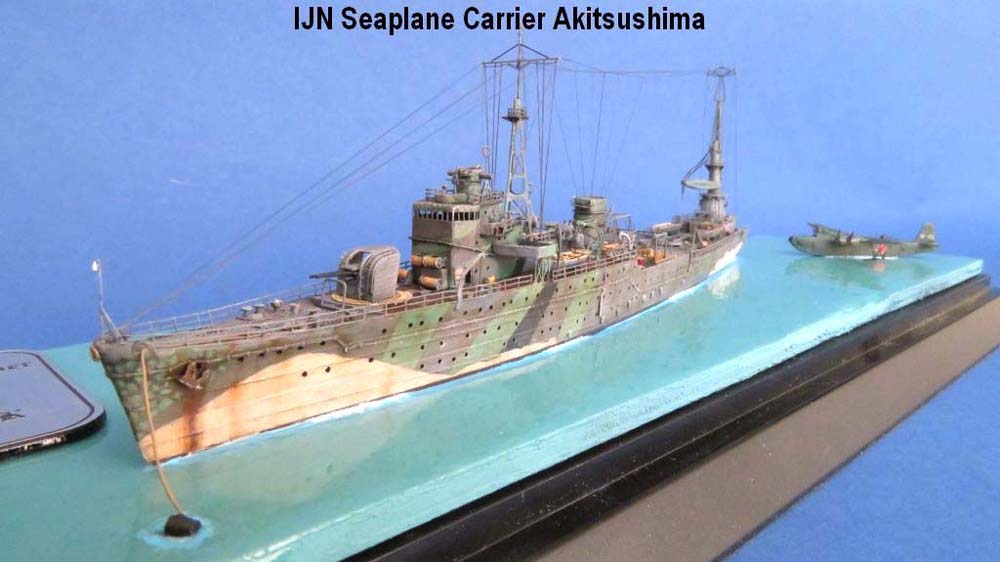
1/700 IJN Akitsushima (Pitroad)
|
by Christian Hoeltge |

1/700 IJN Akitsushima (Pitroad)
In order to reach Pearl Habour on Hawaii with flying boats, Japan could only choose the Marshall Islands as a starting point. But since there were no supply and maintenance facilities for flying boats, they wanted to carry this out with a seaplane tender. In 1939, the tanker Kamoi was upgraded. However, it couldn`t take flying boats on board. The result was the demand for a tender specially designed for flying boats such like the H6K. Two ships were planned to be built, one with a displacement of 10,000 t and one with 2,400 t. These plans were rejected for financial reasons and so a new draft with a displacement of 3,500 tons was created. The ship should serve for maintenance, repair and supply. The flying boats should first be brought on board with a skid, but they later decided to achieve this with a 35t crane. The Akitsushima was laid down on October 29, 1940 and one year later the Chihaya was also laid down. While the Akitsushima was put into service on April 29, 1942, the Chihaya was canceled. Finally, the displacement of the Akitsushima was 4,650t and it had a length of 114.8m. As a defense armament she had two 12.7 cm twin AA guns and two 20mm twin AA guns. The Akitsushima could take a flying boat of the type H6K or H8K with the crane on board. But this was only possible when the ship was at anchor.
Shortly after commissioning the Akitsushima was sent to the Shortland Islands. She was there to help with the sea rescue of downed aircraft because the battle for Guadalkanal raged not far away. There she was slightly damaged by a bombing raid and she was in 1943 again on patrol between Kavieng, Mewe, Rabaul, Buka and the Shortland Islands. There the destroyer Hakaze needed help and she could save most of the crew. In 1944, Akitsushima remained in Truk and was there during the US bombing on February 17. Akitsushima received three bomb hits, but was able to return to Yokosuka for repair. Since in the attack the repair ship Akashi was sunk, the Akitsushima was converted to arepair ship. She therefore received appropriate repair facilities. A big crane, needed for the task, was already there. In September 1944 she reached the Coron Bay in the Philippines. However, on 24 September, there was an air raid and the Akitsushima was hit by bombs. In the process, aviation fuel ignited and exploded. Nevertheless, the bulk of the crew could be rescued. There died only 82 men and 4 officers.The kit is the older kit one from Pitroad. Meanwhile, there is a newer kit from Aoshima. However, I wanted to use the accessory set of Artist Hobby and so I took the Pitroad kit. In principle, only the fuselage remained from the kit and the rest was replaced. Forgive me, but that's always a special challenge for me. Masks are included in the accessory set to drill out the portholes as they are only indicated slightly. With Mr Surfur I added a plank structure to the hull. This somewhat negates the monotony of the tall hull. A bigger problem was the different references. There were always differences between plans, the different kits, built models and the accessory set. I tried as far as possible to stick to the existing original images and the rest is then a compromise and I do not vouch for one hundred percent accuracy. In the end, however, the construction should be fun and the result should look good. For further detail I took one of Shelf Odditys 12.7 cm AA guns on the bow. The 12.7 cm AA gun in front of the chimney was in the conversion kit and is probably a copy of the one from Ocean Spirit. Unfortunately, the 9m cutters from the kit have ejector pins inside them, so I took two from my spare box and refined them with etched parts from FiveStar. However I used 12m motoboats as were very nicely detailed. In the accessory set the etched parts for the motor boats were available. In addition there came ammo crates, wooden boxes and barrels from FiveStar and fan outlets from Ocean Spirit. The aircraft engine and the paravane are from Rainbow Model. The H8K floatplane was included in the kit and was refined with etched parts from the accessory set. In addition MG and antennas came from pe reelings leftovers. The water was created this time by first nipping a wood panel with wall paint. Then I painted this and put several layers of model water from Noch over it. This time I wanted to have a rather calm sea. With white paint then smaller waves emerged on the boat and aircraft body.
(Resource: Wikipedia, www.combinedfleet.com)
